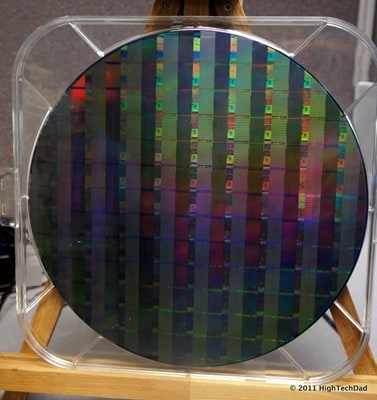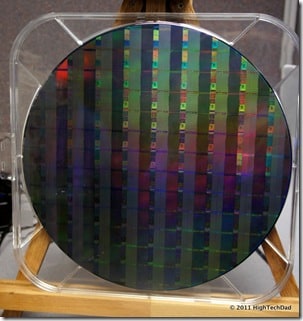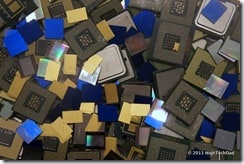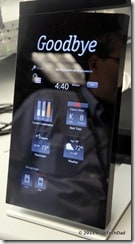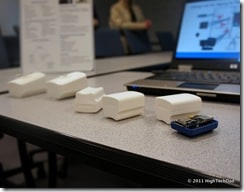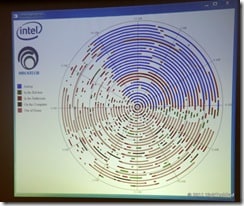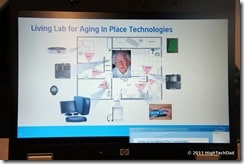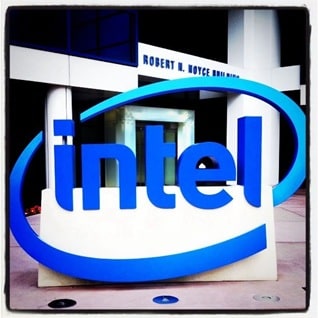A few weeks ago, I participated in the Intel “Upgrade Your Life” 2011 summit in Intel’s Santa Clara, CA campus. This was the second year I attended and after both summits, I always managed to walk away with a headache. But, not a “bad” headache by that definition, but a “good” one. Think about when you go for a very hard run or work out for a long time and your muscles hurt and are sore when you are done…it was THAT type of a headache. In about 8 hours, my mind had sucked in so much new information, that it literally hurt from all of the exercise.
The participants of the “Upgrade Your Life” 2011 event all seemed to have something in common, we were all bloggers and most of us were parents as well and many of us, like me, also write about technology. There were only 2 males/dads in the group, me and Jeff Sass (Jeff and I are 2/5ths of the Cast of Dads podcast), and we did a video recap of some of the things that impressed us about this event in this video “2/5ths of the Cast of Dads Get Their Brains Upgraded at Intel’s ‘Upgrade Your Life’ 2011 Event”. But I thought that I would dive into two other important topics that came from the Intel Labs group: Energy Conservation and Caring for the Elderly.
First off, I have always expressed how much I like the Labs division of companies and Intel’s is no exception. As part of the Intel Advisors program (another group I actively participate in with Intel), some of our best informational conference calls and presentations in my opinion were the ones where people from the Intel Labs group would present us with some new projects that they are working on. So, the two topics of this post and the videos below (from the “Upgrade Your Life” event) are from the Labs groups. There were other quite interesting demonstrations, but I found these two to be timely and critical to think about in this day and age.
I actually got a bit scared when listening to the presentations on these two topics: Energy Conservation and Caring for the Elderly. These are two topics that we need to be not only thinking about, but acting on NOW. And this is exactly what Intel is doing.
“Green is the new Black”
That was the title of one of the sessions at Upgrade Your Life. The session was presented by Suzanne Fallender, Director of Corporate Social Responsibility Strategy and Communications. Suzanne is responsible for working with business groups and senior management across Intel. This includes the environment health and safety, human resources and diversity, supply chain, legal, government affairs and community relations groups. As Suzanne put it, Intel is “a company of engineers – we like to measure everything.” Being able to quantify the direct impact energy awareness and conservation has within an organization as large as Intel is something incredibly daunting, in my opinion. But Suzanne and her colleagues seem to embrace it with vigor and motivation.
Some quick points from this session:
- There are 3 areas of focus: Energy, Water and Waste
- Energy cost savings campaigns are designed to create more demand in the market through renewable energy
- 40 billion gallons of water have been saved by Intel since 1998 as a result of conservation efforts
- Water conservation is both a local and global challenge
- Intel is using different types of water in appropriate ways (e.g., “grey water” is used for watering)
- Intel recycled 80% of solid waste in 2010
- Energy conservation needs to work at both a grid-level as well as at a consumer level
- Advances in technology can drive conservation
A really interesting shift in mentality within the Intel “culture” was to move from the concept of “faster, faster, faster” as related to chips. In the past, consumers wanted the fastest chips possible. Now with mobile computing, consumers are saying they want lower power requirements and longer battery life (but without compromising speed or performance). If you look at two time periods (1980-2007 & 2007-now), there is a dramatic change to exemplify this. The total combined power of the chips produced in the later period are 17 times more powerful, but use 50% less power!
At the previous year’s “Upgrade Your Life” event, we were introduced to some compelling Lab initiatives related to home energy management. I actually filmed a video in the Labs at that event, but unfortunately was unable to release it to the public back then as some of the information was confidential. At this year’s event, I got to see how this technology has evolved and how it is about to be released to consumers in the coming months. So, I thought that it would be important to show both videos (now with permission) and see how things moved from concept to market, all within just a year’s time. Obviously, this has been in development for much longer than a year, but still, it is great to see the speed of innovation.
The concepts shown in these two videos are simple. In order to better conserve energy, you need to be able to understand and monitor how it is being consumed within your home. Just monitoring your consumption can lead to a 15% savings. Actively conserving, based on what knowledge you have gained on your consumption and usage can lead to another 15% savings. In my opinion, anything that you purchase to help this education and conservation process will eventually pay for itself, not only from a cost perspective in your household, but also will reward generations to come as we reduce our energy footprint.
What is demonstrated in these videos is how a single device can essentially get energy fingerprints of all of the devices plugged into your electric grid at home. When you plug in a toaster or use a hair dryer, it will consume energy distinctly, and you will be able to isolate what that particular device is consuming. This may allow you to then choose to change the device to something more energy efficient (e.g., a newer clothes washer or refrigerator) or simply eliminate that device all together.
Below is the video from the 2010 Upgrade Your Life summit (also available here on YouTube):
[iframe_loader width=”560″ height=”349″ src=”http://www.youtube.com/embed/g6jt6fpCYc0?rel=0″ frameborder=”0″ allowfullscreen]
And here is how that same product has evolved (this video is also available on YouTube):
[iframe_loader width=”560″ height=”349″ src=”http://www.youtube.com/embed/X69PLOP2fH4?rel=0″ frameborder=”0″ allowfullscreen]
There are two other pieces of technology discussed in this video that are of interest: LED lighting and switching from AC (Alternating Current) to DC (Direct Current), so I encourage you to watch the full video.
“Re-inventing Aging Through Gray Technologies”
This session presented by Dr. Eric Dishman, Intel Fellow and Digital Health Group Director, was rather sobering. You simply need to think about the following fact for a few seconds to understand what is coming…the “Gray Wave.” By 2020, the population of people over 50 years old will double. By 2050, the population over 50 will double AGAIN! Just think about that. We know that it is coming but is our healthcare infrastructure (not just the US but of the world) ready to handle this? There are currently not enough people in the workforce to pay for all of the retirees. In fact, Alzheimer’s alone could bankrupt Medicare in just 10 years. Countries are failing partially because of aging demographics – it’s a harbinger of what is to come (think bailouts, rising healthcare costs, etc.)
Scary, isn’t it? Given that this Gray Wave is already upon us, what is being done to accommodate it? One place that you can see efforts in action is at a combined initiative from Intel and GE called Care Innovations (http://careinnovations.com/). As described on the site: “Intel-GE Care Innovations™ is a new company aimed at being a catalyst for changing health care models. To do so, we create technology-based solutions that give people confidence to live independently. ”
So what does that mean exactly and how is Intel (specifically the Intel Labs) participating? Basically, it means bringing technology into the care of the elderly. While technology innovations may not eliminate the need for nursing homes, if applied appropriately and in the correct situations, it can enable seniors to be “independent” longer, provide real-time feedback to caregivers and family, and allow doctors and nurses to handle actual healthcare emergencies.
The Intel Labs groups has implemented monitored home environments around the world as a means to prove the use of this technology. By equipping homes with a variety of sensors and input devices, seniors who do not have critical healthcare needs can actually be given the freedom to take care of themselves or at least be a bit more autonomous than previously possible.
The video below talks though how this technology works and how it is being used. (The video is also available on YouTube.)
[iframe_loader width=”560″ height=”349″ src=”http://www.youtube.com/embed/dW3gafCyycw?rel=0″ frameborder=”0″ allowfullscreen]
The “perceptive technology” as describe it truly great, in my opinion. Houses are dumb and currently provide no type of assistance to the aging. A house can quickly become an obstacle course and impede an independent lifestyle. But if outfitted with sensors that monitor how a person is walking, what rooms they are in, the activities that they are doing and how they are interacting with their environment, a home can quickly become a tool to make the aging process more manageable.
Getting the Word Out
One thing that struck me during the entire “Upgrade Your Life” summit was how important it is to educate. A few years ago, if you asked me what Intel does, I would have simply responded “they make chips.” The branding campaigns of “Intel Inside” did a great job of bringing this concept to the consumer marketplace. People were “trained” to look for computers that had that little “Intel Inside” sticker. It is a case study that has been the subject of many marketing courses.
But now, it seems to me that Intel is working to change that perception. Yes, computers still do have those stickers, now with Core i3, i5 or i7 or Atom branding, but the company as a whole is changing how they are perceived. The Intel Advisors program and the “Upgrade Your Life” summits are also good examples of how Intel is educating consumers and interacting with influencers to paint a larger picture of what Intel is really about. The two examples above on Energy and Aging are just a couple examples of a huge number of things that Intel is doing to better our lives and the lives of future generations.
It almost seems to me that Intel should create a new campaign called “Intel Outside” – out in the environment, out interacting with people around the world and out having direct conversations with people and changing their lives in the process.
Disclosure: In accordance to the FTC Guidelines and WOMMA Code of Ethics, I am disclosing that Intel Corporation has covered my travel and costs related to my visit to Intel’s California-based offices. Additionally, I have a material connection because I received a gift or sample of a product for consideration in preparing to write this content. I was/am not expected to return this item or gift after my review period. More information can be found in my About page as well as here.
HTD says: How are YOU making an impact on the world for future generations as a business or individual?
